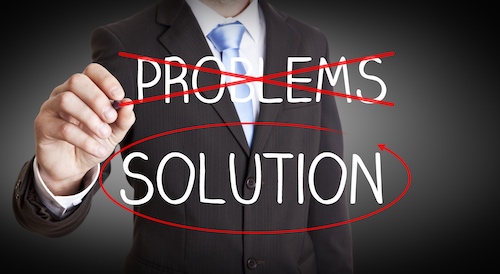 The pendulum continues to slowly drift toward patentees in this post-Alice world. Last week, in Ancora Technologies v HTC America, the Federal Circuit reversed a lower court’s invalidity ruling under 35 USC §101 by concluding that Ancora’s claimed subject matter was concrete—not abstract—because it assigned specific functions to specific parts of a computer to improve computer security. The claims at issue were directed toward selectively limiting use of a software application on a computer. To do so, the computer stores certain license data in a specified part of its BIOS memory, and verifies against that stored license data to permit or prevent use of that software on the computer.
The pendulum continues to slowly drift toward patentees in this post-Alice world. Last week, in Ancora Technologies v HTC America, the Federal Circuit reversed a lower court’s invalidity ruling under 35 USC §101 by concluding that Ancora’s claimed subject matter was concrete—not abstract—because it assigned specific functions to specific parts of a computer to improve computer security. The claims at issue were directed toward selectively limiting use of a software application on a computer. To do so, the computer stores certain license data in a specified part of its BIOS memory, and verifies against that stored license data to permit or prevent use of that software on the computer.
The district court ignored the specific requirements of the claims and simply abstracted the concept to “selecting a program, verifying whether the program is licensed, and acting on the program according to the verification.” Reversing the lower court ruling, the court pointed out that this analysis clearly ignores the concrete requirements of the claims—using a part of the computer (a specific portion of the BIOS memory) to solve the technical problem of preventing unauthorized use of software. Instead, this claim focuses on a specific improvement in computer capabilities using the BIOS memory.
To support its position, the court discusses other Federal Circuit cases finding non-abstract concepts that improve computer functionality, including:
- A behavior based virus scan (Finjan)
- Self-referential tables that improved the way computers operated and handled data (Enfish)
- A specific way to store a certain type of data in cache memory (Visual Memory)
- A method of making web sites easier to navigate on a small screen (Core Wireless Licensing)
- A method of navigating through three dimensional spreadsheets using a specific structure—tabs (Data Engines Technology)
In a manner similar to these past cases, the claims here relate to use of a specific part of the computer that improves computer performance. In other words, these claims involve a concrete way of solving a technical problem in computer technology. The court reiterated that software can make non-abstract improvements to computer technology (from Enfish), particularly when the claims focus on specific asserted improvements in computer technology as opposed to processes in which computers are used merely as a tool (also from Enfish).
The court contrasted this case and the patentee favorable cases noted above with another computer security case, Intellectual Ventures v Symantec, in which the claims merely installed virus protection in a telephone network. The court reasoned that the Intellectual Ventures claims were abstract because they neither relate to any improvement in virus scanning, nor solve any problem associated with a telephone network. Indeed, the claims of the Intellectual Ventures case are quite broad.
This case is yet another in a string of post-Alice cases suggesting that patents should be drafted with an emphasis on the technical problem and technical solution delivered by the claims. In other words, for similar technologies, the patent draftsperson should describe and claim how the innovation uses the computer or other technology in a specific, new manner to overcome technical hurdles. In this case, the court also considered Ancora’s discussion, in the patent, contrasting the claimed solution with other prior art technological solutions to the same problem (e.g., writing a license signature on the computer’s hard drive or requiring insertion of a dongle into a computer port), which seemed to help convince the court both that the invention was directed to a problem that arises in technology and that the invention provided an improvement to computer technology. The patent draftsperson thus should avoid generic claims that simply apply old technology to a computer. Instead, claiming improved technology and using a computer or other technology in a specific manner can help improve the odds of protecting commercially valuable software innovations, especially where specific improvements over prior art technologies can be demonstrated. As an added bonus, this approach also will pay dividends when protecting the claimed technology overseas, such as in Europe.

![[IPWatchdog Logo]](https://ipwatchdog.com/wp-content/themes/IPWatchdog%20-%202023/assets/images/temp/logo-small@2x.png)

![[Advertisement]](https://ipwatchdog.com/wp-content/uploads/2024/04/UnitedLex-May-2-2024-sidebar-700x500-1.jpg)
![[Advertisement]](https://ipwatchdog.com/wp-content/uploads/2024/04/Artificial-Intelligence-2024-REPLAY-sidebar-700x500-corrected.jpg)
![[Advertisement]](https://ipwatchdog.com/wp-content/uploads/2024/04/Patent-Litigation-Masters-2024-sidebar-700x500-1.jpg)

![[Advertisement]](https://ipwatchdog.com/wp-content/uploads/2021/12/WEBINAR-336-x-280-px.png)
![[Advertisement]](https://ipwatchdog.com/wp-content/uploads/2021/12/2021-Patent-Practice-on-Demand-recorded-Feb-2021-336-x-280.jpg)
![[Advertisement]](https://ipwatchdog.com/wp-content/uploads/2021/12/Ad-4-The-Invent-Patent-System™.png)






Join the Discussion
9 comments so far.
Mark Nowotarski
December 12, 2018 08:55 amAnon @8,
Thanks for your comments. I’m not sure what you mean by “The Bilski case refutes what you state here?” Are you referring to the edit I made to the Wikipedia article “Useful art”? I believe it’s consistent with your comment above that there is a divergence of opinion on the High Court as to whether or not a business method is a useful art.
Regarding your point “the ability of most anyone to amend Wiki…”, I think you have a misunderstanding of the nature of Wikipedia editing. Yes, anyone can go in and edit an article, but how long that edit lasts depends upon the nature of the edit and the attention the article has from other Wikipedia editors. All content in Wikipedia must be backed up by a reliable secondary source. If you introduce content that isn’t backed up by a source, other editors will remove that content fairly quickly.
Having said that, there are many articles on Wikipedia that do not get a lot of attention. The extent to which you rely on the content on any given article is a function of in part of how much attention said article gets.
Anon
December 11, 2018 10:31 amMark,
The Bilski case actually refutes what you state here.
The concurrence (actually dissent) of that case would have had the Supreme Court rewrite the words of Congress directly on that point.
I have talked with a particular Justice which colors my view that Stevens LOST his majority position because he wanted to outlaw business methods.
As I stated, the ability of most anyone to amend Wiki makes for an especially poor mechanism for basing legal understanding on legal terms of art.
Just don’t do it.
Mark Nowotarski
December 10, 2018 04:59 pmAnon@6. True, but it is certainly helpful to the average person if a relevant article on Wikipedia is updated to properly reflect what a term of art means.
In this case, I took the opportunity to update the article “Useful art” to clarify that under current US patent law jurisprudence, there is a diverging opinion on whether or not a business method is within the useful arts. See In re Bilski
Anon
December 8, 2018 08:22 amPlease do not base your understanding on Wikipedia.
Especially for a legal term of art.
We are far apart for what that term means in US jurisprudence (regardless of attempts to convert the US system into a more HARMonized version).
Paul Cole
December 7, 2018 04:32 pm@ Anon 2
I looked up useful arts in Wikipedia and got the following: “Useful art, or useful arts or technics, is concerned with the skills and methods of practical subjects such as manufacture and craftsmanship.”
Respectfully, I doubt whether a business method falls within that definition unless there is something tangible involved.
So perhaps we are not so far apart after all.
Night Writer
December 7, 2018 03:42 pmProcessing information is a technical problem. Processing information takes time, space, and energy.
The conservation of information is one of the most important laws in physics.
Ternary
December 7, 2018 01:26 pm“… subject matter was concrete—not abstract—because it assigned specific functions to specific parts of a computer to improve computer security.”
That “specific parts of a computer” was the BIOS, which is generally not used as a common accessible storage medium. Using any RAM, DRAM, or other over-writable memory such as EPROM, is of course as technical and concrete as the claimed BIOS memory.
Some doubt is reasonable that the CAFC would have come to a different conclusion about abstractness if the claimed memory was not a BIOS, but still very concrete and technical.
Rather than concluding that the “The pendulum continues to slowly drift toward patentees in this post-Alice world” I conclude that the system is as crazy as before, if not crazier, if it is based on the fact that BIOS memory is “less abstract” than general memory.
Anon
December 7, 2018 10:50 amMr. Cole,
As a European practitioner, I can the (unfortunate) bias that you have in thinking that “technical” (nowhere defined, in a non-circular manner, as I recall), somehow means the same thing as the US “Useful Arts.”
To wit, business methods (as a general notion) falls well within the Useful Arts, and is only “shoehorned” into European practice in regards to acceptability when “technical” is reached.
Mind you, I have no problem whatsoever with any Sovereign to set up their own patent system as they see fit.
I do (very much) have a problem when people do not recognize Sovereign differences and expect (or even assume) that no such differences exist – or worse, that the “eyeglasses that work for them” necessarily work for everyone else.
Paul Cole
December 7, 2018 05:11 amAs a European practitioner, I could not agree more with the need to identify a technical problem and a technical solution. It should be recalled that Constitutional authority for patents is to improve the useful arts.
It is also advantageous to avoid needless generality and to include in the main independent claims sufficient clearly technical features to make it difficult for the court to categorise the claimed subject matter as a mere idea.